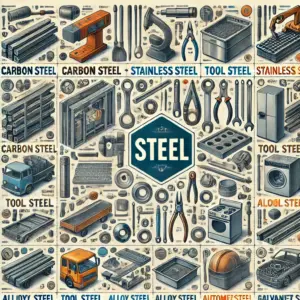Key Takeaways
- Steel is an essential component in various industries for its strength and versatility.
- Different types of steel offer unique properties suited for specific applications.
- The knowledge of these steel types can help make informed decisions for projects.
Understanding different steel types helps in selecting the right material for various applications. Carbon steel offers strength and affordability, stainless steel resists corrosion, and alloy steel enhances durability. Tool steel is ideal for cutting applications, while galvanized steel provides rust protection. Each type serves unique industrial and construction needs.

Introduction to Steel Types
Steel stands out in the world of materials as one of civilization’s cornerstones. Its exceptional strength, flexibility, and affordability blend have made it indispensable in the construction and manufacturing industries. The secret behind steel’s versatility lies in combining iron with carbon and other elements, which alter its diverse properties. This customization allows steel to cater to various applications. For instance, Specialty Steel alloy steel distributors offer a wide range of steel types designed for specific industrial uses, ensuring that every project finds its perfect match, maximizing performance through tailored solutions.
Carbon Steel: A Staple in Construction
Occupying the frontline of steel types, carbon steel is the industry workhorse, representing a significant portion of global steel production. Carbon steel, well-known for its durability and affordability, is the most widely used material in construction because of its capacity to bear large loads, which is essential for creating structures and bridges that will last over time and natural forces. As highlighted in a comprehensive study by AZoM, carbon steel’s ubiquitous use is bolstered by its ease of fabrication and high tensile strength. These attributes make it adaptable to various structural applications, providing economical yet robust solutions for infrastructure development.
Stainless Steel: The Shining Star
Stainless steel is widely used because of its low chromium concentration of 10.5%, which forms a passive coating that inhibits corrosion and makes it perfect for items exposed to harsh conditions and dampness. Its aesthetic appeal and easy-to-clean surface make it desirable in decorative architectural projects. The automotive and aerospace industries use stainless steel for components that need to endure high temperatures and pressures. Stainless steel is woven into everyday life, from cutlery and kitchen appliances to modernist architecture. Its hygienic properties make it essential in food processing and health equipment. Moreover, its sleek, modern appearance attracts designers for its use in art installations, furniture, and contemporary building facades.
Tool Steel: A Cut Above the Rest
Tool steel is a crucial material in manufacturing due to its superior hardness and heat resistance, derived from elements like tungsten, molybdenum, and vanadium. It produces machinery parts, dies, and molds that require precision. The tool’s ability to withstand wear and tear without losing efficiency extends its lifespan and boosts operational productivity. The choice to use tool steel is based on its ability to maintain form and sharpness under pressure, ensuring precision in every cut and mold. Its durability minimizes tool replacement frequency, leading to consistent production timelines and reduced costs, which is essential in competitive manufacturing environments.
Alloy Steel: Customizable and Resilient
Alloy steel, a versatile material made from iron and other alloying elements like nickel, manganese, and chromium, is a popular choice for automotive and pipeline manufacturing industries due to its ability to maintain structural integrity under mechanical stress and varying environmental conditions. Its greatest strength is its adaptability, which enables producers to create steel that either meets or surpasses contemporary technical difficulties, from infrastructure resistant to seismic activity to lightweight car components. This versatility drives innovation, product design, and functionality efficiency, making alloy steel a prime candidate for various industries.
Galvanized Steel: The Protective Layer
Galvanized steel’s robust protective qualities underscore its role in construction and infrastructure development. A zinc coating shields galvanized steel from oxidation, extending its life expectancy even when exposed to harsh outdoor conditions. Sought after for roofing, fencing, and piping, galvanized steel’s longevity and low maintenance requirements make it a cost-effective solution. Its striking metallic sheen adds to its visual attractiveness, and its protective qualities guarantee structural stability, particularly in coastal areas where moisture and salt are common problems.
Choosing the Right Steel for Your Project
- Consider the Environment: Evaluate the environmental conditions the steel will face, such as exposure to moisture or extreme temperatures.
- Evaluate Weight and Strength Requirements: Balance the structural demands with the need for lightweight components where applicable.
- Check for Compliance: To ensure performance and safety, ensure the chosen steel type complies with applicable industry requirements and certifications.
Future Directions for Steel
As industries confront environmental concerns, the future of steel production lies in sustainability. Emerging technologies pave the way for greener manufacturing practices, such as electric arc furnace production, that lower carbon emissions and energy consumption. This move towards sustainable steel is supported by continuous research and development. According to findings from ScienceDaily, novel production strategies that focus on waste minimization and resource efficiency hold promise for an eco-friendly industry.
Conclusion
Steel, a versatile material with diverse applications, showcases human ingenuity and advancement. Understanding each type’s attributes helps decision-makers choose the most suitable material for various applications. Steel shapes our environment securely and sustainably, shaping our skyscrapers and surgical tools. As we progress, steel will remain at the forefront of infrastructure and technology innovation.



